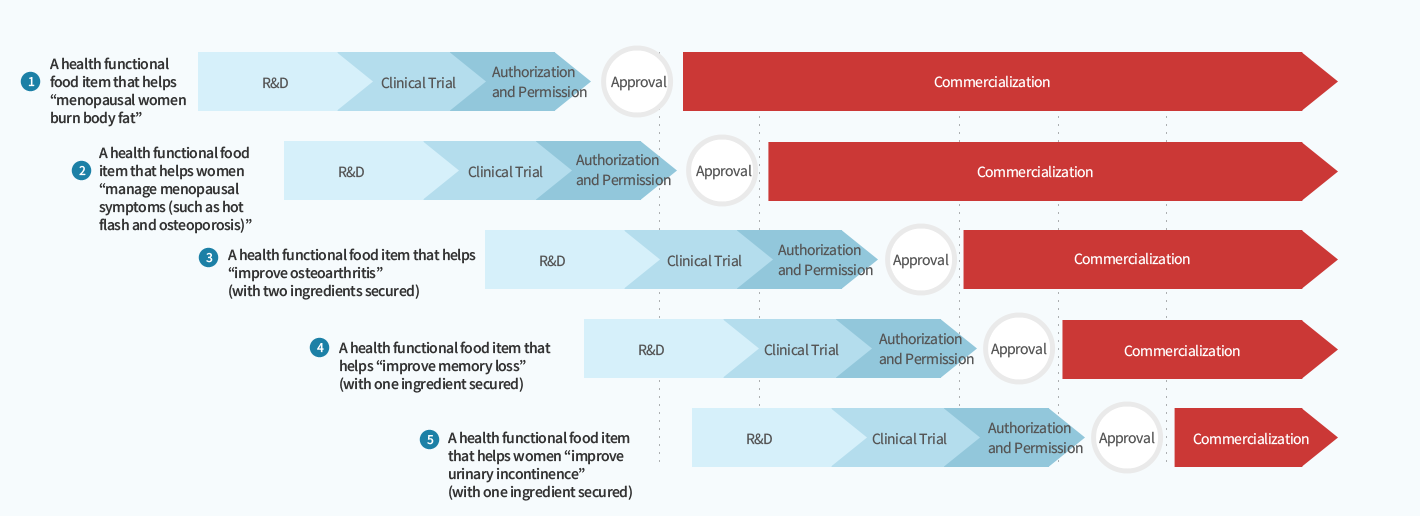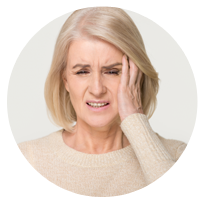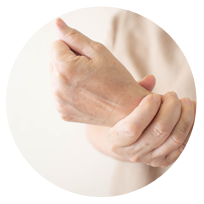R & D
Health Functional Food Development
At our Central Research Center, an excellent team of researchers with master’s and PhD degrees have been carrying out R&D for the development of health functional foods tailored for middle-aged and older women.
We specialize in health functional food to help women manage menopausal symptoms, weight gain, osteoporosis, osteoarthritis,
memory loss, cognitive decline, and urinary incontinence.
We are in charge of the entire R&D process for the development of health functional food that encompasses finding effective ingredients by exploring domestic and overseas natural materials, separating and purifying potent ingredients, developing extraction methods for maximizing potency, choosing indicator ingredients, standardizing manufacturing processes, proving their efficacy through cell adhesion and animal testing, overseeing toxicity testing in animals, testing potential treatments in human volunteers (clinical testing), and obtaining approval from the Korea Ministry of Food and Drug Safety.
Women’s Menopause
Signs and symptoms of menopause
-
Menopause refers to the time between perimenopause and postmenopause. During perimenopause, estrogen levels generally decline. Menopause happens when estrogen and progesterone levels are very low, and menstruation stops. The postmenopause is defined as the time after which a woman has gone 12 months without having her period.
Most women reach menopause around the age of 50, but it may occur at different ages, depending on their constitution and diet. Because of drastic changes in female sex hormones before and after menopause, they experience various symptoms.
Menopausal symptoms vary from person to person. Some of them include depression, hot flash, and night sweat. It is widely known that women experience various menopausal symptoms. Reportedly, these symptoms have been reducing middle-aged women’s quality of life, and are likely to lead to chronic diseases such as osteoporosis, osteoarthritis, cardiovascular diseases, urinary incontinence, and cognitive decline along with physical aging. Thus, it is vital to come up with a way to reduce menopausal symptoms and prevent chronic diseases.
-
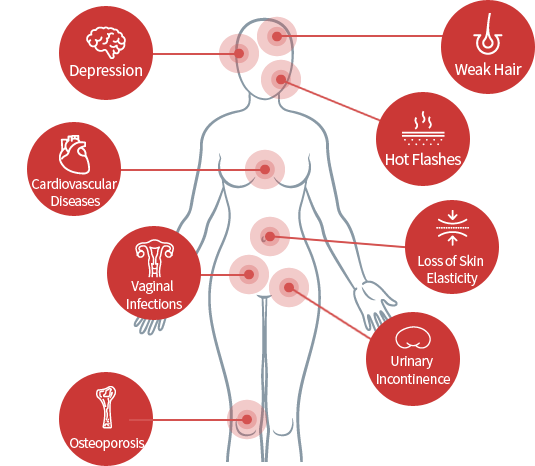
Obesity in Women’s Menopause
Increasing obesity in menopausal women
Middle-aged women before and after menopause are prone to becoming obese. In particular, abdominal obesity and visceral fat accumulation are the biggest risk factors for adult diseases in middle-aged women. As you need enough estrogen even after menopause, the precursors of estrogen in abdominal fat and muscle cells are converted to estrogen. To make up for the drop in estrogen levels after menopause, abdominal fat becomes active, which can lead to obesity. Because overnutrition is common nowadays, the prevalence of obesity is increasing even more.
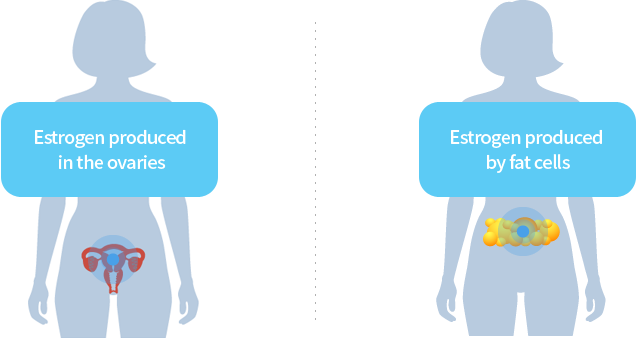
Maintaining proper estrogen levels is crucial to keep healthy life even after menopause in women
- Abdominal fat and muscle cells secrete androstenedione, the precursor to estrogen.
- Abdominal obesity occurs when abdominal fat cells are active. > This will make you gain belly fat.
Obesity rates and prevalence among middle-aged menopausal women
Obesity rates are dramatically increasing among women around age 50. Out of 6 million obese women in Korea, 1.8 million are menopausal.
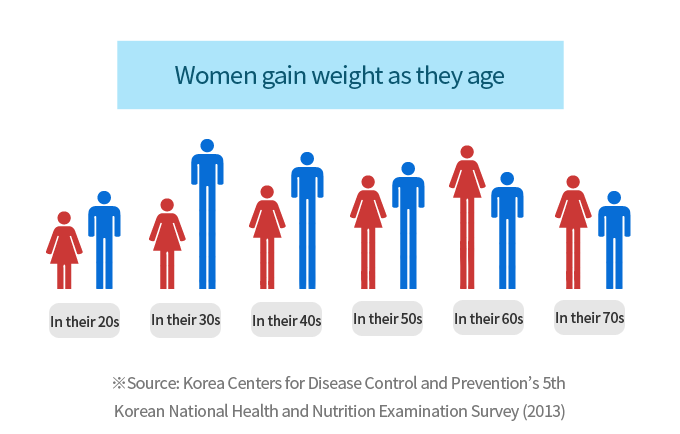
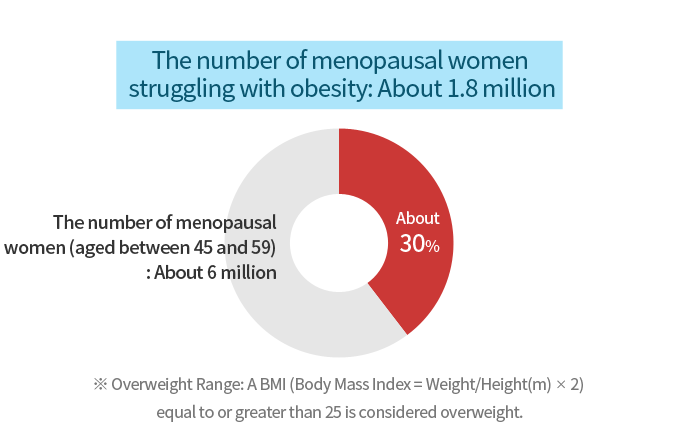
Differences between obesity in middle-aged menopausal women and obesity in general
Even if the causes of obesity in middle-aged menopausal women are different from those in children, teenagers, and middle-aged men, there are not many weight loss supplements tailored to these women.
-
Children and Teenagers
- Poor nutrition
- Lack of exercise
-
Middle-Aged
Men- Poor nutrition
- Lack of exercise
- A decrease in metabolism
-
Middle-Aged Women
- Poor nutrition
- Lack of exercise
- A decrease in metabolism
- Changes in female hormone levels
The causes of obesity in menopausal women are different from those in general.
Osteoporosis and Osteoarthritis
A rapidly aging society
The prevalence of degenerative diseases caused by the rapid aging of our country is increasing. As of 2019, Korea’s aging index is the same as the average of developed countries; however, Korea is predicted to age faster than other countries. Given this, there is a dramatic increase in the number of patients with osteoporosis and osteoarthritis, two of the most common degenerative diseases. These diseases have a three to five times higher prevalence, especially among women, which are associated with a decrease in female sex hormones. Because of the nature of these diseases, you can either prevent or alleviate them, or treat their symptoms through long-term medication. Thus, it is necessary to develop health functional food made with ingredients derived from nature, which have fewer side effects.
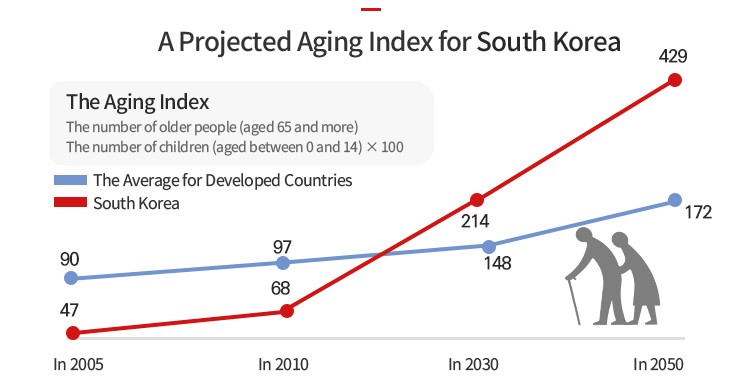
A Projected Aging Index for South Korea
What is osteoporosis?
Osteoporosis is a disease of progressive bone loss associated with an increased risk of fractures. It can be best characterized by low bone mass, structural deterioration of bone tissue, and loss of bone mineral (mainly calcium) density.
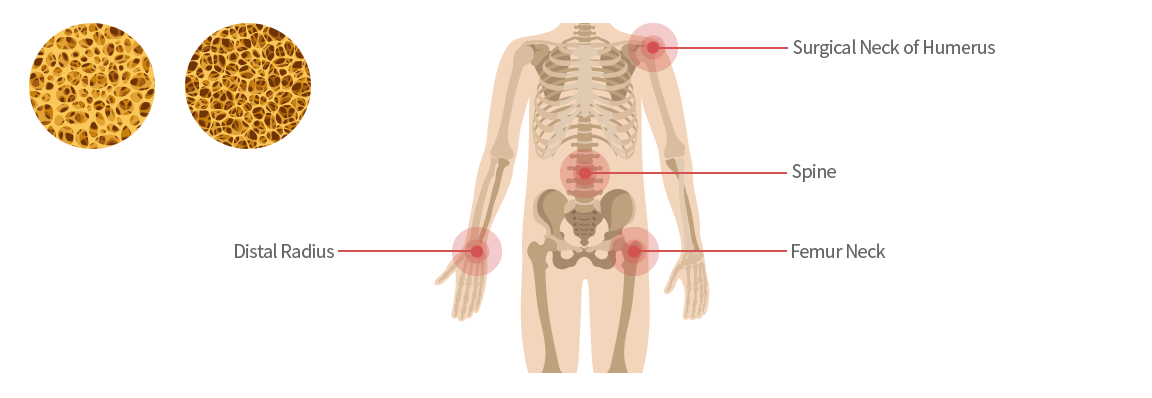
Body parts prone to osteoporosis
Causes of arthritis
Osteoarthritis, also known as degenerative joint disease, is characterized by the degeneration of cartilage and structural changes in the subchondral bone. Its major causes include the breakdown of cartilage because of joint overuse as part of the aging process, cartilage damage caused by genetic factors or impact, pressure, joint loads common in overweight people, and weakened knee muscles. There are only symptomatic treatments such as pain management and surgery, not the curative ones.
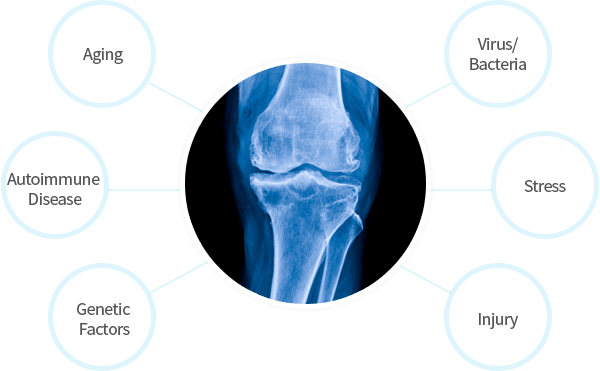
R&D Road Map
Health Functional Food

